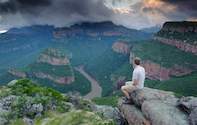Blyde National Park To Be Declared In September
The new national park is a place of many firsts, and is already heralded internationally as a new era in national park creation. One of the park's firsts is that it brings one of the richest collections of plant and animal species on earth under formal protection, linking up a mosaic of different landscapes like mountain grasslands, mistbelt forests and woodlands and savanna bush.
This incorporates some of South Africa's rarest species, many of which are threatened with extinction. It is also the first national park to be looked after by a provincial authority. In terms of new environmental laws, the Mpumalanga Parks Board, now officially known as the Mpumalanga Tourism and Parks Agency (MTPA), manages the park instead of Sanparks. In keeping with new visions for bringing conservation and people together, such as discussed at the last World Park's Congress, the MTPA is looking after the park for successful land claimants.
The descendants of those people evicted from the land many years ago became partners with the state, allowing the state to become custodians of the land, while the communities benefit from the area's tourism potential. As highlighted at the signing of the memorandum of agreement for the creation of the park at Bourke's Luck on August 19, 2004, local communities are empowered to play a significant role in the new park which van Schalkwyk said "is expected to inject R500 million into the local economy over the next ten years."
The park initially covers an area of 44 000 hectares, but in excess of 10 000 hectares added as commercial pine plantations in the area are rehabilitated and returned to a more natural state over the course of several years. Minister van Schalkwyk was positive about the creation of the new park, saying, "Blyde has the potential to become one of the fastest growing malaria-free tourism destinations in Africa."
Did You Know?
The Blyde River Canyon is the third largest canyon in the world, after the Grand Canyon in America and the Fish River Canyon in Namibia.
- It is up to 1,000 metres deep and five kilometres wide.
- About 500,000 people visit the Blyde River Canyon areaevery year.
- The canyon forms part of the Wolkberg centre of endemism, and many of the plants growing in the canyon grow nowhere else on earth. The area is thought to contain the richest combination of plants and animals in southern Africa.
- Some of the plants on the escarpment are related to the fynbos in the Cape.
- The sub-tropical mist belt forests that occur on the mountain are some of the best specimens in the whole of South Africa.
- Mariepskop alone hosts more than 1,400 plant species, and the greater area has some 2,000 species - more than the entire Kruger National Park. Of these, 163 species are threatened with extinction and listed in the Red Data plant book.
- The planned national park will have representatives of 75 percent of all bird species, 80 percent of all raptor species and 72 percent of all the mammals found in South Africa.
- There are more than 100 different mammal species in the park, including more than 20 types of carnivores, such as leopard, caracal and serval.
- There are at least 335 bird species in the park
- 94 reptile species and 34 amphibian species occur there, including some of the rarest frogs in the country.
- Many of the 33 fish species that occur in the river are on the verge of extinction
- More than 200 species of butterfly and almost 70 species of spider have been recorded in the area.
- Alien plants pose one of the biggest threats to the area's biodiversity.
- The Sand River, which rises in the national park, supplies water to no less than 420,000 people, and is a tributary of the Sabie River that runs through Kruger.
Visit Blyde River Canyon Nature Reserve


